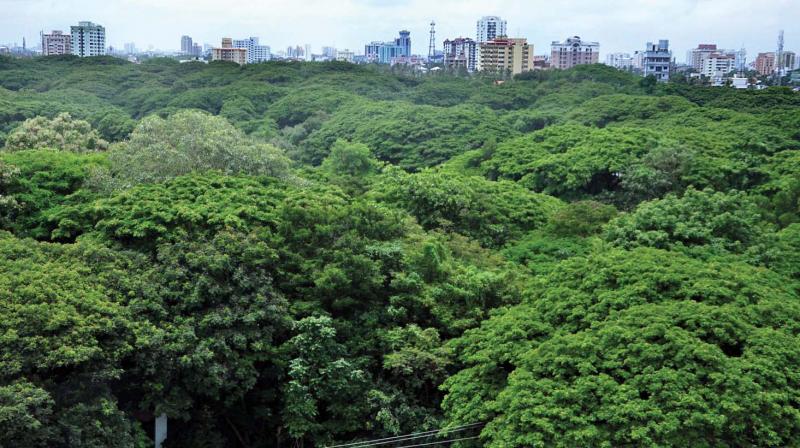The money plant
It now seems as if the only thing of value in a tree is its timber. It is high time a tree is valued for the ecological services it renders.

THIRUVANANTHAPURAM: Two years ago three mature trees - a tamarind, a jackfruit and a mango - at the west side of former bureaucrat Gopalakrishna Panicker’s then 20-cent ancestral house in Pongummoodu in the capital had to be cut down for the construction of a public drain. It was a common cause and Mr Panicker had willingly parted with two cents of his property. He did not think twice about cutting down three grandmother trees either. But in a matter of months, during the next summer, he had to install air-conditioners in two rooms. “I am not sure about the science but it became unbearably hot the summer after the trees were felled. It was not just the air-conditioners, we had to put up a shade over our balcony on the western side,” Mr Panicker, a former additional secretary, said. There is a new breed of environmentalists in the West, called ‘treeconomists’, who can attach a monetary value to the loss suffered by Mr Panicker. The figure will not be something simplistic like the cost the house owner had to incur on two air-conditioners and the plastic sheet extension over the balcony.
THE PRICE OF A TREE
These factors will of course be given weightage but the price tag for each tree will be arrived at after a highly nuanced calculation that will include the tree's innate capacity to store carbon, prevent the surface run-off from flowing into the drains, reduce ultraviolent radiation and air temperature, and also its incidental benefits like shade and coolness. The health benefits will also be factored in. In Toronto, for instance, researchers had recently found that people living on tree-lined streets reported health benefits equivalent to being seven years younger or receiving a $10,000 salary rise.
“At the moment the only value the state gives a tree is its timber value,” said Mr Sridhar Radhakrishnan of Thanal. It is the rupee value that the Social Forestry officials, in their wisdom, bestow on a tree before it is felled. The tree is then auctioned with this value as the base price. “The value set for a tree is laughably low,” Mr Radhakrishnan said. Ms Anitha Sharma of Tree Walk, which fights for the protection of trees in the capital, said that a large rain tree, which is said to have a bottomless capacity to store carbon, that was felled recently at the Attankulangara School in the capital was assigned a timber value of Rs 71.
Five hours to the West in London, ‘treeconomists’ have assigned an ecological value of 52,000 pounds or nearly Rs 48 lakh for a single ‘plane tree’, which has a considerably less ecological value than a rain tree. Mr Radhakrishnan said that it was time for the state, too, to value trees in terms of the ecological services they provide. “The first step would be to have a single authority in charge of maintenance and protection of trees in non-forest areas,” Mr Radhakarishnan said. The Social Forestry wing of the Forest Department should be given the task, he said. Now, a tree is cut according to the whims of the institution head or the individual within whose premises the tree is standing. “Earlier, before the LDF came into power, the decision to cut a tree in a non-forest area was taken by a district-level tree committee. These bodies have now become defunct,” said Mr Radhakrishnan, who was a member of the Thiruvananthapuram district-level tree committee.
REFINE THE MESSAGE
A rewording of the ‘green message’, making it utilitarian, can perhaps force people to think in terms of giving trees their true value. Ms Sharma said that recently a group of educated youth was furious with her for trying to protect a tamarind tree that was sought to be felled for the laying of a drain. “But when I told them that a tamarind tree absorbs 50,000 kg of carbon in its lifetime, some of them turned calm all of a sudden,” she said. Kerala Forest Research Institute, which had always talked in generalities, now has evolved a language that is more targeted. “Telling people in the capital that the Agasthyamala forest is rich in biodiversity might at best evoke a bored smile. But if we tell them that their water requirement depends on the Agasthyamala forest, then they might perk up their ears,” said Dr T V Sajeev, a senior scientist at KFRI.
The state is yet to evolve a mechanism that could reveal the true value of our trees but the KFRI has come close. The Institute has now begun a process to assess the ecological services rendered not by individual trees but by various kinds of forests - rain forests, deciduous, mangroves, shola. “The study includes the air quality around a forest, the ambient climate, the amount of water a forest can hold, and the water balance a forest achieves (how much of water is absorbed by the forest and how much it releases to non-forest areas),” Dr Sajeev said. Though the KFRI study is a major leap in environmental economics, a green revolution will take place only when the state has acquired the ability to assess almost accurately in money terms the loss suffered by the likes of Mr Panicker, who had lost the trees in their backyard.

